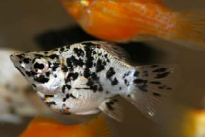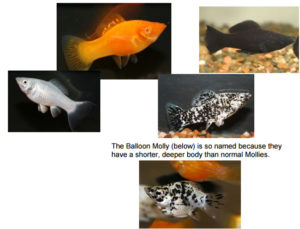
 The Molly is extremely peaceful, and makes an ideal community fish.
The Molly is extremely peaceful, and makes an ideal community fish.
Common Name(s) : Molly
Family : Poeciliidae
Genus: Poecilia
Species : Poecilia velifera
Origin : North Amaerica / Central America / South America
PH : 6.8 – 7.5
Hardness : Moderate to Hard
Temperature : 18 – 28°C
Maximum Size : Males – 7cm / 2.9″ Females – 7cm / 2.9″
Lifespan : 3-4 years
Aggression Level : Low (1/10)
Recommended Tank Size : 30 Litres +
Strata : Visits all areas
TANK SET UP
A planted tank suits the Molly requirements. Bunch plants like Wisteria, Blue Stricta, Green Pennywort, Purple Temple will create lots of hiding places for their Molly fry.
To go one step further with with the breeding needs of fry, you could consider adding some Java Moss – a fast growing very bushy plant that is extremely dense and the perfect hiding place for the young baby fish. Anchor down the clump of Java Moss with a rock or driftwood.
SUITABLE TANK MATES
- Tropical Fish
- Dwarf Cichlids
DIET
Omnivores, in the aquarium they will take a wide range of foods including flake, pellets, vegetables, bloodworm or brine shrimp.
SEXING AND BREEDING
Male and female Mollies are easy to distinguish. Males have a modified anal fin, this is called the gonopodium. This is the male sexual organ. Males can grow up to 7cm while females can get to 6-7cm.
Mollies are livebearers and are extremely easy to breed. The females are almost always pregnant and will give birth to live fish every 4 to 6 weeks. Often the mother will have between 20-70 fry.
Because these fish are avid breeders, it is recommended that at least 3 females should be kept to each male, so the females aren’t continually harassed. Also for the same reason, a tank housing both male and female mollies would ideally contain plants so the females can hide from keen males.
If you wish to breed the Molly it is recommended that a separate breeding tank be set up to separate the mother from the community tank, taking at least half of the existing community tank water. If the mother is not separated and is allowed to give birth in the community tank, more than likely the fry will not survive as the other fish (even including the mother) will eat them.
Often birthing can be induced by raising the water temperature to 28C. After the birthing has finished, usually after 1 to 3 hours, the mother should be removed and returned to the community tank.
Raising the fry is reasonable simple. They should be feed on frozen baby brine shrimp for the first three days. They can then be moved onto fine crushed flake food. Water changes are needed regularly, even daily as the fragile fry are very susceptible to water pollution.
OTHER USEFUL INFORMATION
Mollies are perfectly at home in a peaceful community aquarium. They will generally inhabit the middle strata of an aquarium.
Being omnivores, Mollies will eat a wide variety of food. Mollies will accept and do well on flake along with live and frozen foods such as brine shrimp and bloodworms. Algae is an excellent food source and should be left to grow on certain ornaments or one side of the tank, so the fish can nibble on it between meals. It is a good source of vitamins B, C, D and E.
Mollies are available in a wide variety of colours and patterns including gold, black, white, silver, brown and other types such as the dalmation molly.
A separate variety is the shorter bodied balloon molly.
